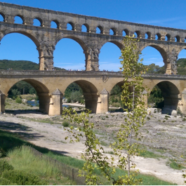
During a summer hiking adventure in southern France, I had the opportunity to visit the Point du Gard. This structure is an ancient Roman aqueduct crossing the Gardon River and part of a 31-mile system that once carried water from the city of Uzès to the Roman colony of Nîmes. Built in the first century it is now a UNESCO World Heritage Site. The aqueduct carried an estimated 44 million imperial gallons of water a day supplying baths, homes, and fountains to 50,000 citizens. Amazingly the height drop of the entire aqueduct’s length is only 56 feet, demanding a gradient of 1 in 3,000. What precision! The system was used into the sixth century and, possibly, some sections of the aqueduct were used past this time.
As a testament to the Roman architects and hydraulic engineers, the bridge stands 160 feet high and is composed of three levels. Cranes and block and tackle pulleys were used to lift huge blocks of stone to construct the bridge. The bridge was built without mortar or clamps in about five years. The entire aqueduct took about 15 years to build, employing between 800 and 1,000 contractors and skilled workers. Marcus Vipsanius Agrippa, Emperor Augustus’ son-in-law and aide, is credited with the construction. It was a huge undertaking, demanding a single-minded focus. Given my engineering background, I stand in appreciation of the accomplishment.
If this aqueduct were under construction today the process would look much different. Environmental concerns; labor, safety and compensation affairs; construction methods; contracting processes; funding acquisition; and governmental regulations would serve to make significant improvements…in discrete aspects of the project. But given the two unrelenting forces of accelerated change and complexity, such a colossal project might well get bogged down and fail to become reality. Well-meaning interest groups and governmental regulatory agencies could possibly derail such an effort. They would not necessarily target the project itself, but the lack of collaboration toward a viable solution would delay construction and escalate costs at best. Or, at the worst, be the project’s demise.
Pushing narrow agendas without working to create the vision can serve as a deathblow.
For instance, in the Pacific Northwest region of the United States we seem unable to build a replacement bridge spanning the major north-south interstate highway across the Columbia River, even after spending millions of dollars on planning and environmental studies. Disputes over scope and funding have brought the project to a standstill. Similarly, the San Francisco-Oakland Bay Bridge eastern span (replacing the section of the bridge damaged in the 1989 earthquake) was plagued with controversy about design and building processes. When it finally opened in 2013, it cost $6.4 billion. Yes, it is beautiful bridge with its signature span. And it is the most expensive public works project in California’s history. A short distance away, the famous Golden Gate Bridge had $76 million set aside by the state to rig it with suicide nets; funding that seems woefully inadequate given the lowest initial low bid of $142 million to fully outfit the bridge.
These are just bridges, but they illustrate how single-minded subsystems run amok can undermine the progress of the whole project. Now, consider the purpose of the aqueduct to supply water. Today, we have added subsystems to ensure the safety of the water. Yet, the revelation that dangerous levels of lead are being delivered to communities demonstrates dysfunctional behavior and infighting of governmental agencies. Neither finger pointing nor providing bottled water serve to create a deep understanding of what went wrong, how to avoid problems in the future, and how to fix current problems. Why does it seem getting important things done is slow and terribly expensive, if accomplished at all? Are we going backwards?
Seeing the whole, without getting lost in the individual pieces, is a real skill. With so many subsystems being developed (and imposed), the whole is suffering. This doesn’t mean the parts and their myopic objects are not important, just that the capacity to integrate the pieces into the whole is often missing. Getting important work accomplished can be deterred because of ‘the tyranny of the subsystem’ or special interest groups. A dissociated collection of parts (interests and processes) does not add up to something great. It is about the parts and the whole.
As recently as a few decades ago, mammoth endeavors were accomplished: placing 12 men on the moon, building record-setting skyscrapers and power generating dams, constructing enormous highway systems, and creating a world-wide information system supported by a network of earth-orbiting satellites. Now, simply building a house can seem like a herculean task given the number of codes, regulations, and development fees that need to be dealt with.
Please do not be mistaken. I am not calling for abandonment of the good flowing from creating subsystems, nor am I suggesting we need emperor leadership (nor emperor son-in-laws) in public service or business. We do need leaders, subsystem owners, and participants to be better collaborators. There are numerous examples where this is happening, but it is becoming more difficult as change accelerates and complexity increases. Attending to the whole and working toward an entire project is required to make giant visions a reality…as well as making the gains found in subsystems hold.
So, hats off to the first century Romans and their building feat. But, for us, let’s demand more collaboration and holistic thinking from ourselves and from leaders to deal with a with a much more complicated world with change increasing exponentially. Let us discover meaning and common ground in the big vision, keeping our eyes on creating something together. New tools and methodologies for collaborative creation are in the market. Maybe it’s not too late for us to learn new skills.



